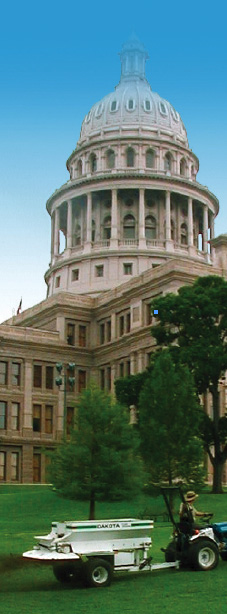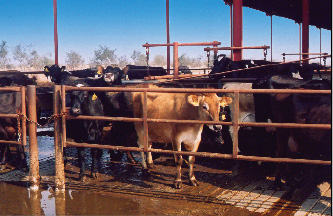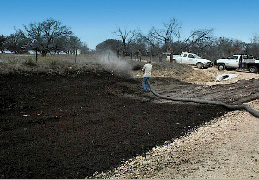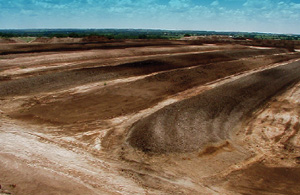
Hauling manure off-site for
composting is proving to be a good manure management solution for dairy
farms in north-central Texas, but the composting companies are facing
challenges marketing all the finished material.
Hauling manure off-site for composting is proving to be a good manure management solution for dairy farms in north-central Texas, but the composting companies are facing challenges marketing all the finished material.
 Compost produced from dairy manure in the North Basque River Watershed is applied on the lawn of the Capitol in Austin, Texas. Compost produced from dairy manure in the North Basque River Watershed is applied on the lawn of the Capitol in Austin, Texas.
Photos by Bill Carter, Texas Commission on Environmental Quality
|
The 15-year and ongoing effort to manage the manure generated by intensive dairy farming in the North Bosque River Watershed area of north-central Texas makes it abundantly clear why proper manure management practices starting at the farm gate are a critical aspect to any farming operation.
Only a massive effort on the part of state and federal authorities to educate farmers about proper manure management practices, installation of lagoons, and an aggressive composting program have significantly reduced the amount of manure being applied to area farmland. A better understanding of application rates and crop rotation has also improved manure management practices. The result: The risk of significant manure run-off into the North Bosque River has been reduced.
What continues to be of great concern, however, is that the North Bosque River flows into Lake Waco, which serves as a water supply reservoir for more than 200,000 people in the city of Waco and surrounding communities.
The lure of cheaper farmland, an amenable climate, and greater market demand for dairy products from the Dallas/Fort Worth metropolitan area resulted in significant growth in the Upper North Bosque River Watershed, a 453 square-mile area. There was a 148 percent increase in the number of cows to over 50,000 by the late-1980s alone. Today, that number is closer to 80,000.
The majority of new dairy owners came from California and Arizona, where land prices had gotten too expensive, according to Jim Buck, manager of Producers Compost Co. This composting company is one of six established as part of the Upper North Bosque River Hydrologic Unit Project. It is the largest compost incentive program ever attempted in Texas, and probably in the United States. Texas set a goal of composting half of the manure generated in the North Bosque River Watershed, and by 2003, had already achieved 28 percent.
A survey of participating dairy farmers and compost company operators leaves little doubt that everyone is pleased with the effort and the results of the project, whose main objective was to reduce contaminant levels into the North Bosque River partially as a result of surface run-off from farm land where manure had been applied.
Steve Vanden Berg and his wife, Sara, operate Vanden Berg Dairy, about an hour southwest of Dallas/Fort Worth and a mile from Producers Compost Co. The ten-year-old dairy sends all of its manure to the composter, and Vanden Berg says his neighbors are doing the same. The cost of shipping the manure to the composter is subsidized by the state government.
 Offering relatively cheap farmland—and with greater market demand for dairy products from the nearby Dallas/Fort Worth area—the Upper North Bosque River Watershed has seen tremendous growth in the number of dairies and cows. Offering relatively cheap farmland—and with greater market demand for dairy products from the nearby Dallas/Fort Worth area—the Upper North Bosque River Watershed has seen tremendous growth in the number of dairies and cows. |
The Vanden Bergs milk about 600 cows. The manure generated by their dairy herd is scraped from the pens daily using a tractor and scraper into a settling basin. A trucking company owned by Steve’s father, Jack, picks the manure up every three months, as well as from a number of other dairy farms in the area, and delivers it to Producers Compost Co.
“I think having access to the composters is a huge bonus to the dairy industry,” says Steve Vanden Berg. “We have to remove some of the manure from this watershed and composting is the easiest way to do it.”
Furthermore, composting adds value to the manure. At the composting facilities, the manure is heaped into long mounds, or windrows, in which decomposition occurs over a period of between 90 and 120 days. The build-up of internal temperature kills pathogens and weed seeds in the manure, leaving a compost with a much lower moisture content that can be sold as a soil amendment or for erosion control.
From a financial perspective, the ability to dispose of the manure at composters has a direct benefit to the dairy producers’ bottom line, as there is no need for capital investment in manure spreaders and internal manure management equipment systems if all the manure is disposed of in this way.
However, there was a major capital investment by many area dairies into lagoons. Educating local farmers on the value of lagoon storage and treatment of dairy wastewater resulted in the construction of 103 new dairy lagoon systems.
Vanden Berg farms about 217 acres of cropland to grow feed for his dairy herd, but does not use any of the herd’s manure as organic fertilizer because of another problem that many dairy farmers in that area of Texas experience, which is excessive phosphorus build-up in the soil.
Manure is proven as one of the main contributors to phosphorus build-up. Vanden Berg’s decision reflects another important component of the overall North Bosque manure reduction initiative, the generation of 101 dairy farm nutrient management plans. As a result of the plans, manure application rates on farmland were reduced by an average of 20 tons per acre per year. Nitrogen and phosphorus loading into the watershed was reduced by an estimated 2.2 million and 1.01 million pounds respectively.
Encouraging farmers to use effective nutrient cycling processes when they apply manure to cropland is also saving them about $1 million annually in commercial fertilizer costs. Many have also adopted the practice of year round crop rotation, seeding rye grass in the cooler months, to generate another cash crop and to ensure year round nutrient uptake from the soil, thereby creating more manure intake capacity on the existing land base.
In tandem with adopting better manure management and crop rotation practices, farmers also discovered ways to significantly reduce the amount of wastewater they generate. Replacing manure flush systems using water with a scrape and hand wash process along with a water recycling system, reduced fresh water use by 75 percent, translating into a reduction of 2.5 million cubic feet of water per year for an average dairy.
Redirecting manure generated on dairy farms to composters has met with reasonably good success. Figures from August 2003 showed that 450,000 tons of manure had been hauled out of the North Bosque River Watershed, and another 226,000 tons from another manure reduction program on the Leon River. Marketing the composted material continues to be a challenge, though.
Producers Compost Co, owned by Jim Beyer, has been in business since 2001. It has been producing between 50,000 and 60,000 cubic yards of compost per year from manure delivered to the operation from area dairy farms, but has enough capacity to produce up to 200,000 cubic yards. On the equipment side, the company uses a 20-foot Scarab compost turner, manufactured in White Deer, Texas.
Getting enough manure from local dairy farms isn’t the problem, says Jim Buck. “There is just about an endless supply of manure,” he says. “We take all that we have room for.”
 Manure in windrows in one of the large composting yards participating in the compost incentive project. Manure in windrows in one of the large composting yards participating in the compost incentive project. |
At present, the composter has about 150,000 cubic yards of compost stockpiled, with 99 percent of its product sold to the Texas Department of Transportation. It’s used as soil amendment in areas where construction work has just been completed on roads, rights-of-way, and parks. “The Department of Transportation has been really good,” says Buck. “They’ve implemented this program to help the counties with the manure problem, and they’ve done a good job. You want them to do more, but there is just so much they can do.”
The problem with marketing this compost is its weight. The composters established in close proximity to the dairy farms are competing with those already established in the Dallas/Fort Worth metropolitan area. Compost from the dairy manure weighs between 1,000 to 1,500 pounds per cubic yard, whereas the compost being generated from material like yard waste by city-based composters weighs only about 500 pounds per cubic yard. So given the cost of transportation, especially with this added weight, the composters are finding it hard to compete without government assistance.
 Compost being applied on a roadside right-of-way. Compost being applied on a roadside right-of-way.
|
“If we could just get a market for the compost, the program would be great,” says Buck. “There wouldn’t be any manure left here in the watershed. They’d get rid of all of it.”
As an incentive to help market the dairy compost, the Texas Commission on Environmental Quality, has established a rebate of $3 per cubic yard for purchases of qualifying composted dairy manure, up to a total of 4,000 cubic yards per customer, and a $5 per cubic yard rebate for government purchasers. The non-government purchasers have to be located outside the North Bosque River area, and in the case of agricultural producers, they must first develop a nutrient management plan before qualifying for the rebate. The plan helps producers determine the amount of compost needed. A total of $180,000 was provided by the federal Environmental Protection Agency (EPA) to encourage more compost sales. The program ends in August, 2006.
Both the dairy industry and composters acknowledge that the government assistance provided so far was meant to get proper manure management practices and composting established. Eventually, the businesses will have to prove that they are economically viable through the development of reliable markets for the compost, without the need for massive government assistance. However, given the potential liability resulting from water supply contamination, it’s unlikely that the either the state or federal authorities will exit the scene any time soon.